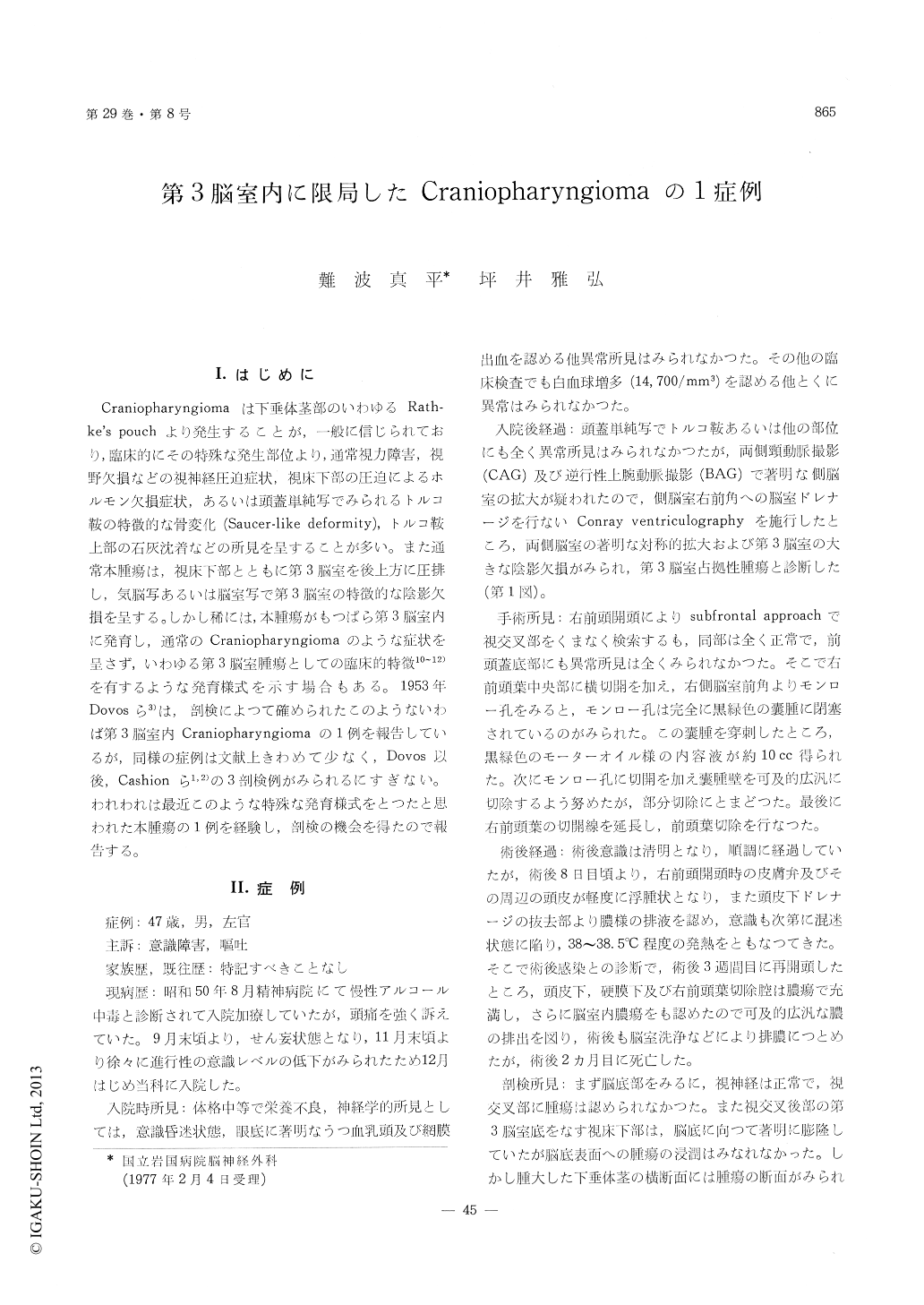Japanese
English
- 有料閲覧
- Abstract 文献概要
- 1ページ目 Look Inside
I.はじめに
Craniopharyngiomaは下垂体茎部のいわゆるRath—ke's pouchより発生することが,一般に信じられており,臨床的にその特殊な発生部位より,通常視力障害,視野欠損などの視神経圧迫症状,視床下部の圧迫によるホルモン欠損症状,あるいは頭蓋単純写でみられるトルコ鞍の特徴的な骨変化(Saucer-like deformity),トルコ鞍上部の石灰沈着などの所見を呈することが多い。また通常本腫瘍は,視床下部とともに第3脳室を後上方に圧排し,気脳写あるいは脳室写で第3脳室の特徴的な陰影欠損を呈する。しかし稀には,本腫瘍がもつばら第3脳室内に発育し,通常のCraniopharyngiomaのような症状を呈さず,いわゆる第3脳室腫瘍としての臨床的特徴10〜12)を有するような発育様式を示す場合もある。1953年Dovosら3)は,剖検によつて確められたこのようないわば第3脳室内Craniopharyngiornaの1例を報告しているが,同様の症例は文献上きわめて少なく,Dovos以後,Cashionら1,2)の3剖検例がみられるにすぎない。われわれは最近このような特殊な発育様式をとつたと思われた本腫瘍の1例を経験し,剖検の機会を得たので報告する。
A 47-year-old male was transferred to our hospital on December 3, 1975 with consciousness disturbance and frequent vomiting. His consciousness level was semicoma at admission and neurological ex-amination revealed bilateral papilledema and marked retinal bleedings. Plain skull X-P was normal. Carotid angiography showed symmetrical dilatation of the bilateral lateral ventricles. Conray ven-triculography revealed a large space-taking lesion in the third ventricle. Third ventricular tumor or craniopharyngioma was therefore suspected. At operation right frontal craniotomy was performed. But neither tumor nor any abnormal findings were detected by detail obserbation around the optic chiasm and subfrontal area. Right frontal horn of the lateral ventricle was therefore opened. It was detected that the Monro's foramen was almost completely obstructed with yellowish-green cyst located in the third ventricle. Only the upper portion of the cyst wall was removed through the foramen after the aspiration of the cyst fluid.
His consciousness level recovered to the normal after the operation. But he died with severe suppurarive meningitis 2 months after the operation.
Necropsy was done. Though basal view of the cerebrum didn't show any tumor around the optic chiasm and at the subfrontal areas, apparent tumor tissue was found on the cut surface of the pituitary stalk. It was noted that hypothalamus at the cerebral base was markedly protruded, neverthless there was no infiltration of the tumor on the hypothalamic ventral surface except the cut surface of the pituitary stalk. Third ventricle was signi-ficantly dilated, filled with solid grey tumor which was found histologically craniopharyngioma of squamous-cell type. Hypothalamic tissue which constitutes the floor of the third ventricle was histologically examined as well, and it was found that there were still some degenerative glial cells outside the tumor capsule in the cerebral base. And it was further noted that squamous-type tumor cells were also found in the pituitary stalk which was continuous with the apparent tumor in the cut surface of the pituitary stalk.
With these findings, we concluded that the tumor is squamous cell type craniopharyngioma growing exclusively in the third ventricle. Some previous reports of the craniopharyngioma in the third ven-tricle were also reviewed.

Copyright © 1977, Igaku-Shoin Ltd. All rights reserved.


